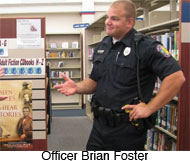4/10/2014
Iowa Appeals Court Endorses Remote Pacing For Speeding TicketsIowa Court of Appeals approves police officer technique of pacing a vehicle from a block away.

Police officers in Iowa can now issue speeding tickets to motorists driving on a different street more than a block away. The state Court of Appeals last month upheld the conviction of Michael Lee Querry based solely on the testimony of an officer who performed remote pacing.
On April 1, 2011, Newton Police Officer Brian Foster saw a white Pontiac Grand Am make a "quick" right-hand turn. He was a block away and decided to pursue in the residential neighborhood where the speed limit is 25 MPH. Michael Querry was in the Grand Am on East Eleventh Street, and Officer Foster was following on East Tenth Street, which runs parallel, 350 feet away.
Officer Foster testified that he followed for a block and a half, maintaining a steady 35 MPH in the residential neighborhood while looking over to South Eleventh Street to ensure he was keeping pace. The road in question is lined with trees and there is no truly clear line of sight through the homes between the streets except at one intersection and beyond the final stop sign.
Officer Foster pulled Querry over and arrested him when he saw marijuana in the Grand Am. Iowa District Court for Jasper County Thomas W. Mott upheld the traffic stop as legitimate, rejecting Querry's argument that the pacing method was absurd. The three-judge appellate panel sided with Officer Foster.
"Although Querry contests the use of the officer's 'pacing technique' as a reliable observation that Querry violated the posted speed limit, our supreme court has found the use of the technique to be reliable," Judge David Danilson wrote for the Court of Appeals.
On the road in question, a block and a half runs about 890 feet, or 0.16 miles. This is less than the generally accepted minimum pacing distance. Pennsylvania statute, for instance, sets a minimum distance of 0.30 miles for a pace to be valid (75 Pa C.S. Section 3368). This means Officer Foster spent was speeding through the residential neighborhood with his eyes looking away from the road in front of him, possibly catching a glimpse of the target vehicle once or twice in the course of 17 seconds.
"Although these circumstances do not reflect an ideal pacing methodology, Officer Foster's observations provided a rational inference that Querry was violating the speed limit and gave the officer probable cause to initiate the traffic stop of Querry's vehicle," Judge Danilson concluded.
The court upheld Querry's conviction. A copy of the decision is available in an 85k PDF at the source link below.


